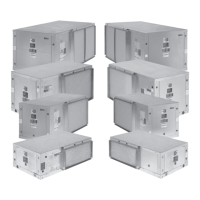to approximately 10 psig and adding sufficient dry nitrogen
to bring the pressure to a maximum of 125 psig. The unit
should then be leak tested with a Halide or electronic leak
detector. After making any necessary repair, the system
should be evacuated as described in the following
paragraphs.
CAUTION: Do not use oxygen to build up pressure. A
serious explosion could be the result.
EVACUATION
After it has been determined that the unit is tight and there
are no refrigerant leaks, the system should be evacuated.
The use of a vacuum pump with a pumping capacity of ap-
proximately 3 cu.
ft./min.
and the ability to reduce the vacuum
in the unit to at least
1
millimeter (1000 microns) is recom-
mended.
The first pull down will remove about 90% of the
non-
condensibles, the second about 90% of that remaining
from the first pull down and after the third only 1
/1
0 of 1
o/o
non-condensibles will remain.
Table 12, page 10, shows the relationship between pressure,
microns, atmospheres, and the boiling point of water.
A mercury manometer, electronic or other type of micron
gauge should be connected to the unit at a point remote
from the vacuum pump. For readings below 1 millimeter,
an electronic or other micron gauge should be used.
The triple evacuation method is recommended and is par-
ticularly helpful if the vacuum pump is unable to obtain
the desired
1
millimeter of vacuum. The system is first
evacuated to approximately 29 inches of mercury. Enough
refrigerant vapor is then added to the system to bring the
pressure up to 0 pounds.
Then the system is once again evacuated to 29 inches
of vacuum. This procedure is repeated three times. This
method can be most effective by holding system pressure
at 0 pounds for a minimum of 1 hour between evacuations.
CHARGING THE SYSTEM
Model ALP condensing units are leak tested at the factory
and shipped with a holding charge of refrigerant. In the event
the refrigerant charge has been lost due to shipping damage,
the system should be charged with enough refrigerant to raise
the unit pressure to 30 psig after first repairing the leaks and
evacuating the svstem.
After all refrigerant piping is complete and the system has
been evacuated, it can be charged as described in the
paragraphs following. Connect the refrigerant drum to the
gauge port on the liquid shutoff valve and purge the charg-
ing line between the refrigerant cylinder and the valve.
Then open the valve to the mid-position.
If the system is under a vacuum, stand the refrigerant drum
with the connection up and open the drum and break the
vacuum with refrigerant gas.
With a system gas pressure higher than the equivalent
of a freezing temperature, invert the charging cylinder and
elevate the drum above the condenser. With the drum in
this position, valves open and liquid refrigerant will flow
into the condenser. Approximately 75% of the total require-
ment estimated for the unit can be charged in this manner.
After 75% of the required charge has entered the con-
denser, reconnect the refrigerant drum and charging line
to the suction side of the system. Again purge the con-
necting line, stand the drum with the connection up, and
place the service valve
in
the open position.
IMPORTANT: At this point charging procedure should be
interrupted and prestart checks made before attempting to
complete the refrigerant charge. See startup procedures on
page 48.
NOTE: It is recommended that the total operating charge
per circuit be stamped on the unit nameplate for future
reference.
HOT GAS BYPASS COMPONENTS
McQuay offers a “Hot Gas Bypass Accessory Kit” for each
ALP unit size. Each kit includes a solenoid valve, a hot gas
bypass valve and an instruction drawing. See page 55 for
hot gas bypass operation.
Table 9. Hot gas bypass kits
REFRIGERANT CHARGE
Each ALP condensing unit is designed for use with R-22.
Table 10 lists approximate refrigerant charges for operation
of the unit. Additional refrigerant will be needed for the system
piping and evaporator. Estimated total operating charge
should be calculated before charging system. See Table 11
for weight of refrigerant in copper lines.
CAUTION: Total operating charge per circuit should not
exceed the condenser
pumpdown
capacity per circuit. A li-
quid receiver on each refrigerant circuit could be used in this
situation. Refer to the
ASHRAE
Handbook for the design and
installation of piping and components.
Table 10. Approximate refrigerant charge
NOTE: Condenser
pumpdown
capacity is based on ANWASHAAE Standard
15-1978 rating of 90% full of liquid at 90°F. To convert values to the older
ARI
standard (80% full at 80°F). multiply
pumpdown
capacity by 0 888.
Table 11. Weight of refrigerant R-22 in copper lines
(Pounds Per 100 Feet of Type L Tubing)
is/8
1
1.237
1
88.0
1
4.62
1
1.190 1.770
2’h
2.147 153.0 8.04 2.06 3 060
2%
3.312 236.0 12.4 3.18 4.720
31/a
4.728 336.0 17.7 4.55 6.750
3%
6.398 456 0 24.0 6.15 9.140
4’ia
1
8.313
1
592.0
1
31.1
1
8.00
1
11.190
IM
269 I Page
9

